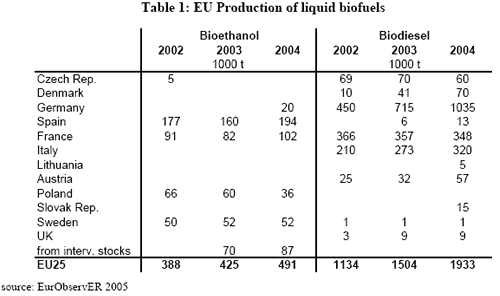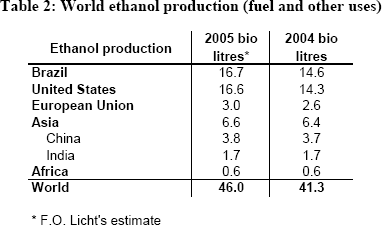|
 << Letze Seite Inhltsverzeichnis Nächste Seite >> << Letze Seite Inhltsverzeichnis Nächste Seite >>
DAS BIOKRAFTSTOFFPOTENZIAL AUSSCHoePFEN
EIN STRATEGISCHES KONZEPT
Biofuels Market Situation
Today, bioethanol is the world’s main biofuel. Biodiesel, which until recently was produced
almost solely in the EU, is now gaining a foothold in many regions across the world. Biogas
comes a poor third and has so far made a breakthrough only in Sweden.
According to EurObservER, the EU’s production of biofuels amounted to 2.4 million tonnes
in 2004: 0.5 million tonnes of bioethanol and 1.9 million tonnes of biodiesel. This is an
increase of more than 25% compared with the previous year and production capacities are
increasing rapidly.
For bioethanol, more than 1 million tonnes are expected by the end of 2005 and capacity is
likely to treble by the end of . For biodiesel, the estimated 66 production sites across the
EU are scheduled to expand to 75–80 plants by the end of 2005. For mid-2006 an increase in
total EU25 biodiesel production capacity to 3.8 – 4.1 million tonnes is expected.

In 2004 world production of bioethanol for fuel use was around 30 billion litres. This
represents around 2% of global petrol use. Production is set to increase by around 11% in
2005. The table17 below shows ethanol production by world region.
Brazil has long been the world’s leading producer of bioethanol. The sugarcane area is
constantly being extended, in order to meet growing domestic and export demand. With
around 1 million flex-fuel18 cars expected to be on Brazil’s roads by the end of 2005, the
availability of bioethanol for export could be reduced, at least in the short term. In the United
States bioethanol output is expanding at an unprecedented rate and now nearly matches that
of Brazil. Canada is a world leader in developing second-generation bioethanol.

In 2004 the European Union, with production of almost 0.5 million tonnes, is estimated to
have produced 10% of the world’s bioethanol. The leading EU producers were Spain and
France. The leading consumer was Sweden, with about 80% of the quantities imported,
mostly from Brazil.
In Asia, Thailand is currently building over a dozen ethanol plants that will use sugar cane
and rice husks. Thailand's ethanol production capacity could rise to 1.5 billion litres a year.
Pakistan, the world’s largest exporter of molasses, is launching a domestic bioethanol
programme to absorb some of the country’s estimated 400 000 tonne production capacity,
following the withdrawal of its special duty free access under Regulation (EC) No 2501/2001,
which allowed it to export ethanol duty-free to the EU. Bioethanol expansion in India was
slowed by a shortage of feedstock, caused by a drought affecting sugar cane production.
Forced to import large quantities of ethanol from Brazil last year, India’s domestic production
should be back on track this year. It produces more than 1.5 billion litres of ethanol annually,
of which only a quarter is used for fuel purposes.
A rapidly growing demand for sugar in the Far East means that increased ethanol production
has to be balanced against a tight world sugar market and strong export potential. China’s
ethanol industry comprises over 200 production facilities in 11 provinces, capable of
producing more than 10 million tonnes of ethanol each year. As food security is a great
concern to China, they have also made investments in Brazil, from where they are likely to
import considerable quantities of ethanol in the future, as will Japan.
A number of ACP sugar-producing countries are planning to diversify into bioethanol, but
whether many of them will be able to produce at sufficiently low cost to be competitive is
uncertain. However, the potential for biofuel production is not limited only to countries that
grow sugar cane. Nigeria is considering the use of cassava, of which it is the world’s leading
producer. Other feedstocks, such as sweet sorghum (for bioethanol) and jatropha (for
biodiesel), require lower fertiliser input, are more resistant to drought and can be grown in any
region of the world. However, yield volatility may reduce their long-term profitability.
The EU is the world’s leading region for the production and consumption of biodiesel. EU25
production increased to almost 2 million tonnes in 2004, with Germany the main producer,
followed by France and Italy.
Around the world, many other countries have now launched biodiesel programmes, using a
wide range of different feedstocks, from cassava to used cooking oil.
The United States’ National Biodiesel Board anticipates that 75 million gallons of biodiesel
will be produced in 2005, or three times as much as in 2004. A federal tax incentive, state
legislation and a diesel shortage are all contributing to a rise in demand. In Brazil a 2%
biodiesel blend will become mandatory in 2008. In addition to developing soya, investments
are also being made to develop production from castorseed, in particular in the poorer semiarid
north-east of the country.
Malaysia, the world’s biggest producer of palm oil, is developing a biodiesel industry, as are
Indonesia and the Philippines. The first two countries will also supply palm oil to new plants
in Singapore, from where biodiesel will be exported. The obligation in India to mix 5%
biodiesel with normal diesel is expected to create an immediate demand of 2.5 million tonnes
of biodiesel, which may increase to 16 million tonnes if the mix is to achieve the target of
20% in 2020.
Fiji is keen to replace 10% of its diesel fuel imports with coconut oil from local copra
production.
Some ACP countries are exploring biofuels options with the help of EU Member States. One
example is a partnership between a Danish laboratory and the University of Dar es Salaam,
Tanzania, which is carrying out fundamental research into the production of ethanol from
lignocellulosic waste materials. The production of bioethanol from agricultural waste in the
developing world can be envisaged with no danger that this would detract from food
production. Feasibility studies are also being carried out on using cotton oil as biodiesel in
Brazil and West Africa.
Production of biogas has increased significantly, but it is used mainly for combined power
and heat generation. Although in Europe more than 500 000 gas-fuelled vehicles have been
sold in recent years, they mainly run on fossil gas. However, biogas as a transport fuel is used
in some countries and Sweden has about 50 biogas refuelling stations.
<< Letze Seite Inhltsverzeichnis Nächste Seite >>

|